The Giza Power Plant (26 page)
F
IGURE
42.
Grand Gallery Resonators
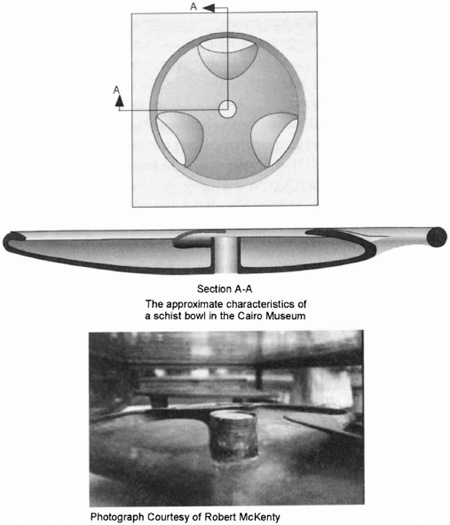
F
IGURE
43.
Schist Bowl
Regardless of the age of these artifacts, the technical accomplishment of the artisans who created the vases and bowls does not support the notion that they worked with primitive tools. I am in full agreement with Hancock, who pondered on an unimaginable technology and said, "Why unimaginable? Because many of the vessels were tall vases with long, thin, elegant necks and widely flared interiors, often incorporating fully hollowed-out shoulders. No instrument yet invented was capable of carving vases into shapes like these, because such an instrument would have had to have been narrow enough to have passed through the necks and strong enough (and of the right shape) to have scoured out the shoulders and the rounded interiors. And how could sufficient upward and outward pressure have been generated and applied within the vases to achieve these
effects?"
14
The questions Hancock posed are legitimate. As a machinist, I have created smaller products with similar geometry, for the aerospace industry. The technique I used to hollow out these modern stainless steel artifacts on a lathe involved drilling a hole and then using a series of L-shaped tools. After the first L-shaped tool had been used to open up the "chamber" bore, I held each successive tool in my hand and "snaked" the L through the neck into the piece before clamping the tool in the tool-holder. Once it was firmly clamped, I had to make sure that it was positioned correctly within the piece before the lathe began to rotate. It was a tricky operation that required the use of a small mirror and a powerful light to see inside the workpiece (see Figure 44).
The work I performed in steel was easy compared to the granite, diorite,
basalt, and metamorphic schist that were cut by the ancient Egyptians. I was extremely puzzled and could not undertand why they went to such trouble to create vases in this manner. We certainly do not go to this trouble to create vases today. Their purpose was obviously very important to have
required such an effort. It then occurred to me that perhaps these stone artifacts were not domestic vases at all, but were used in some other way. Perhaps they were being used to convert vibration into airborne sound. Given their shape and dimensionsâand the fact that there were 30,000 of them found in chambers underneath the Step Pyramidâare these vessels the Helmholtz resonators we are looking for? As if to provide us with clues, one of the bowls in the Cairo Museum has a horn attached to it, and one of the bowls does not have handles normally seen on a domestic vase, or urn, but has trunnion-like appendages machined on each side of it. These trunnions would be needed to hold the bowl securely in a resonator assembly (see Figures 45 and 46).
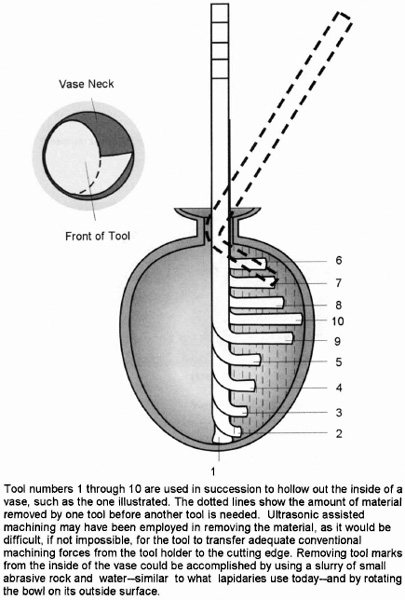
F
IGURE
44.
Machining a Swan-neck Vase
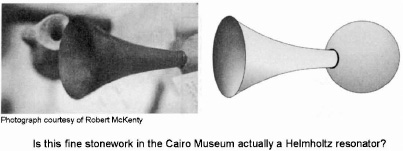
F
IGURE
45.
Vessel with Horn Attached
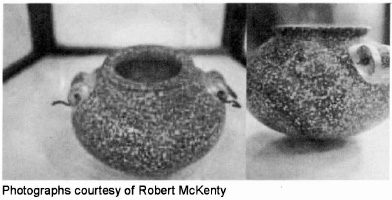
F
IGURE
46.
Precision Machined and Balanced Bowl
Heading back to the Great Pyramid, we find more evidence for our theory. The enigmatic Antechamber has been the subject of much consternation and discussion. Ludwig Borchardt, director of the German Institute
in Cairo (circa 1925), proposed that a series of stone slabs were slid into place after Khufu had been entombed. He theorized that the half-round grooves in the granite wainscoting supported wooden beams that served as windlasses to lower the blocks (see Figure 47).
Borchardt may not have been far off with his analysis of the mechanism that was contained within the Antechamber. After building the resonators and installing them inside the Grand Gallery, the ancient Egyptians would have wanted to focus a sound of specific frequency, that is, a pure or harmonic chord, into the King's Chamber. They would be assured of doing so if they installed an acoustic filter between the Grand Gallery and the King's Chamber. By installing baffles inside the Antechamber, sound waves traveling from the Grand Gallery through the passageway into the King's Chamber would be filtered as they passed through, allowing only a single frequency or harmonic of that frequency to enter the resonant chamber. Those sound waves with a wavelength that did not coincide with the dimensions between
the baffles would be filtered out, thereby ensuring that no interference sound waves could enter the resonant King's Chamber to reduce the output of the system (see Figure 48).
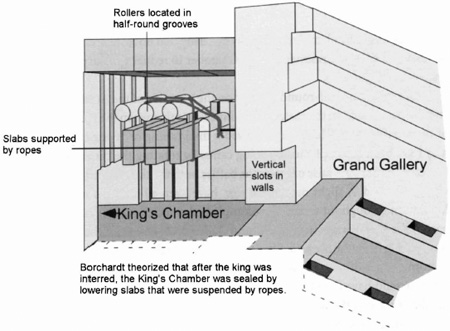
F
IGURE
47.
Borchardt's Theory
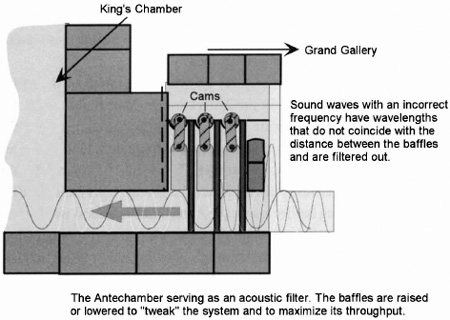
F
IGURE
48.
Acoustic Filter
To explain the half-round grooves on the west side of the Antechamber and the flat surface on the east, we could speculate that when the installation of these baffles took place, they received a final tuning or "tweaking." This may have been accomplished by using cams. By rotating the cams, the off-centered shaft would raise or lower the baffles until the throughput of sound was maximized. A slight movement may have been all that was necessary. Maximum throughput would be accomplished when the ceiling of the first part of the passageway (from the Grand Gallery), the ceiling of the passageway leading from the acoustic filter to the resonant King's Chamber, and the bottom surface of each baffle were in alignment. The shaft suspending the baffles would have then been locked into place in a pillar block located on the flat surface of the wainscoting on the opposite wall.
During my conversations with Stephen Mehler and acoustical engineer Robert Vawter, I discussed my theory of the Antechamber. Vawter confirmed
my analysis that it was used as an acoustic filter and agreed that further studies are needed to quantify the exact physics employed, via "back engineering" the dimensions of the King's Chamber complex.
So, what if my theory is correct and the Great Pyramid was a resonance chamber power plant? The next questions would be how the Egyptians controlled the vibrations to avoid an overload or destructive wave like that which downed the Tacoma Narrows Bridge. Because a vibrating system can eventually destroy itself if there is no means to draw off or dampen the energy, the ancient Egyptians would have had to find some way to control the level of energy at which the system operated. Because the output of the resonant cavity would draw off the energy only up to a certain levelâthat being the maximum amount the granite complex could processâthere would have to be some means of controlling the energy as it built up inside the Grand Gallery.
Normally there are three ways to prevent a vibrating system from running out of control. First, you can shut off the source of vibration. Obviously if the source of the vibration in the Great Pyramid was the Earth itself, the ancient Egyptians could not do this. Second, you can reverse the process that couples the resonator to its source. Third, you can contrive a means to keep the vibrations at a safe level. Because the Great Pyramid's source of vibration was the Earth, options two and three are the obvious choices to solve the problem. We will address number three because, in order for the power plant to continue to function, there must be a constant supply of energy. There are two ways to control a constant vibration. One is to dampen it and the other is to counteract it with an interference wave that cancels out the vibration. Physically dampening the vibration would be impractical, considering the function of the Great Pyramid as a machine. The dampening would not always be necessary, unlike the dampening needs of a bridge, and indeed would have an adverse effect on the efficiency of the machine. It most probably would also involve building moving parts, like dampeners in a piano. Faced with these considerations, I looked more closely at the possibility that the ancient Egyptians may have cancelled out excess vibrations by using an out-of-phase interference sound wave. My inquiry began with the Ascending Passage, for it is the only feature inside the Great Pyramid that contains "devices" that are directly accessible from the outside. If the operators
of the machine found it necessary to cancel out vibrations, they would have to be able to quickly respond to this need from the machine's exterior. I call the granite plugs inside this passage "devices" for the same reason I call the granite beams above the King's Chamber devicesâfor they are over-designed and over-crafted for their supposed use (see Figure 49). In the case of the Ascending Passage, it was not necessary to use granite to block this passage if the ancient Egyptians wanted to keep tomb robbers outâlimestone would have been sufficient. Realistically, limestone would have been better. The very fact that the stones "blocking" this passage are granite contradicts their effectiveness at securing the inner chambers from robbers, which is the orthodox interpretation for their use. In fact, they had the opposite effect, drawing Al Mamun's attention to the existence of the Ascending Passage and, subsequently, to the entire internal arrangement of passages and chambers. No, these granite plugs had to have another reason for being there!

